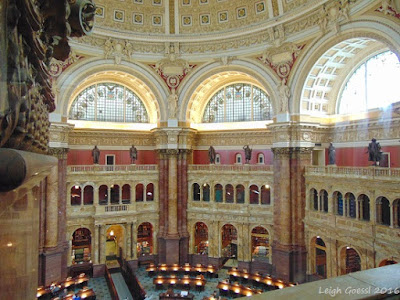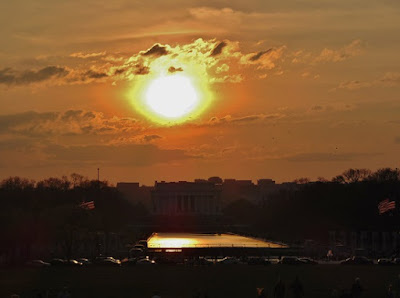Many people travel from afar to see Washington in the spring, so the streets were crowded and lines were long, but we covered a lot of the Mall areas. Earlier my daughter and I hopped the Metro to see the almost to peak cherry blossoms and once our friends arrived, we took on many parts of the city.
Friday was a busy day, first we visited the Supreme Court. I'd visited inside once before, but never sat in on a tour in the actual court. It was a very interesting experience to sit in the highest court in the land and listen to the Q & A session we'd attended.
 |
| Photos are not allowed inside the courtroom, but you can catch a glimpse in this photo |
 |
| Main research room at the Library of Congress |
From the LOC we headed down towards the cherry blossoms as they were peaking at this point. Saw the pre-sunset views which were stunning!
After that, we walked through the Mall and saw the Washington, WWII and Lincoln Memorials as the sun was just about to set. Another gorgeous view!
 |
| Sunset over Lincoln Memorial March 2016 |
Afterwards, we walked down to the National Archives. As expected, there was a long line, but it moved quickly which was great. We didn't stay long. I really like visiting the Archives, but I wish on busy days they'd set up a better viewing system in the Rotunda. The officer asked everyone to be kind to one another during his presentation prior to entering, but clearly a few people weren't paying attention.
At other times of year their system works, but not so much on spring break. My family was shoved out of the queue to see the Declaration of Independence by two tweens and a mother who demanded she needed to "stay with her girls". She pulled the same card a few minutes later to get further ahead of people. One of my friends was actually cussed at by a man who was standing in front of one of the documents with his child in a stroller with his back to it, totally blocking anyone else from seeing the document. Not the best experience there on this trip.
After that we made the trek back up to Union Station where we grabbed a bite to eat and then got on our moonlight bus tour. Now THAT was fabulous. It was the second time I'd done this and, while the one we did last year was good, this one was fantastic. More on this in a future blog post. We had booked our tour with Old Town Trolley and Mike was our guide. Great stuff!
 |
| Marine Corps War Memorial (also referred to as the Iwo Jima Memorial) |
 |
| Photo Credit: DL |
I'd been on or near the Tidal Basin several times this week and I'm really glad we went on Monday. It was the best viewing day of all. The wind made it a bit "snowy", just gorgeous.
 |
| Gorgeous cherry blossoms showing on March 28, 2016 |
 |

























